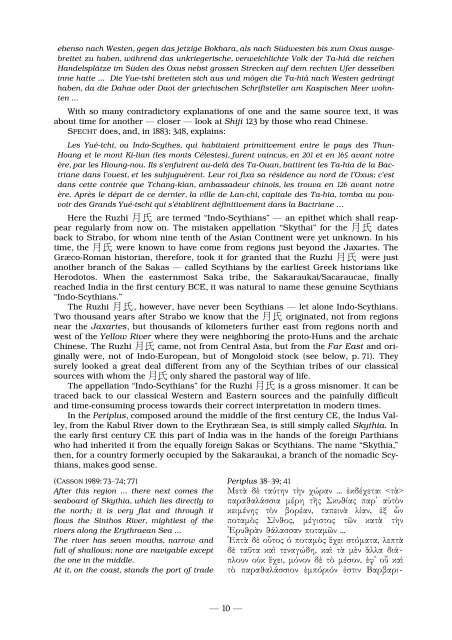張騫 Zhang Qian. The Secret Envoy of Han Emperor Wu in Search of the Arsi (Yuezhi) and the Fall of the Græco-Bactrian Kingdom. (Annotated Compilation of Eastern and Western Sources)
The study undertakes: — to clarify in what year Zhang Qian reached the Oxus river; to establish that the Daxia 大夏 in Shiji 123 represent the Tachar/Tochar of Tochar-i-stan; to explain how we are to understand the "List of Four" in Strabon 11.8.2.
The study undertakes: —
to clarify in what year Zhang Qian reached the Oxus river;
to establish that the Daxia 大夏 in Shiji 123 represent the Tachar/Tochar of Tochar-i-stan;
to explain how we are to understand the "List of Four" in Strabon 11.8.2.
Create successful ePaper yourself
Turn your PDF publications into a flip-book with our unique Google optimized e-Paper software.
ebenso nach Westen, gegen das jetzige Bokhara, als nach Südwesten bis zum Oxus ausgebreitet<br />
zu haben, während das unkriegerische, verweichlichte Volk der Ta-hiâ die reichen<br />
<strong>Han</strong>delsplätze im Süden des Oxus nebst grossen Strecken auf dem rechten Ufer desselben<br />
<strong>in</strong>ne hatte ... Die Yue-tshî breiteten sich aus und mögen die Ta-hiâ nach Westen gedrängt<br />
haben, da die Dahae oder Daoi der griechischen Schriftsteller am Kaspischen Meer wohnten<br />
...<br />
With so many contradictory explanations <strong>of</strong> one <strong>and</strong> <strong>the</strong> same source text, it was<br />
about time for ano<strong>the</strong>r — closer — look at Shiji 123 by those who read Ch<strong>in</strong>ese.<br />
SPECHT does, <strong>and</strong>, <strong>in</strong> 1883: 348, expla<strong>in</strong>s:<br />
Les Yué-tchi, ou Indo-Scy<strong>the</strong>s, qui habitaient primitivement entre le pays des Thun-<br />
Hoang et le mont Ki-lian (les monts Célestes), furent va<strong>in</strong>cus, en 201 et en 165 avant notre<br />
ère, par les Hioung-nou. Ils s’enfuirent au-delà des Ta-Ouan, battirent les Ta-hia de la <strong>Bactrian</strong>e<br />
dans l’ouest, et les subjuguèrent. Leur roi fixa sa résidence au nord de l’Oxus; c’est<br />
dans cette contrée que Tchang-kian, ambassadeur ch<strong>in</strong>ois, les trouva en 126 avant notre<br />
ère. Après le départ de ce dernier, la ville de Lan-chi, capitale des Ta-hia, tomba au pouvoir<br />
des Gr<strong>and</strong>s Yué-tschi qui s’établirent déf<strong>in</strong>itivement dans la <strong>Bactrian</strong>e …<br />
Here <strong>the</strong> Ruzhi 月 氏 are termed “Indo-Scythians” — an epi<strong>the</strong>t which shall reapear<br />
regularly from now on. <strong>The</strong> mistaken appellation “Skythai” for <strong>the</strong> 月 氏 dates<br />
p<br />
b ack to Strabo, for whom n<strong>in</strong>e tenth <strong>of</strong> <strong>the</strong> Asian Cont<strong>in</strong>ent were yet unknown. In his<br />
t ime, <strong>the</strong> 月 氏 were known to have come from regions just beyond <strong>the</strong> Jaxartes. <strong>The</strong><br />
G ræco-Roman historian, <strong>the</strong>refore, took it for granted that <strong>the</strong> Ruzhi 月 氏 were just<br />
ano<strong>the</strong>r branch <strong>of</strong> <strong>the</strong> Sakas — called Scythians by <strong>the</strong> earliest Greek historians like<br />
H erodotos. When <strong>the</strong> easternmost Saka tribe, <strong>the</strong> Sakaraukai/Sacaraucae, f<strong>in</strong>ally<br />
r eached India <strong>in</strong> <strong>the</strong> first century BCE, it was natural to name <strong>the</strong>se genu<strong>in</strong>e Scythians<br />
“ Indo-Scythians.”<br />
<strong>The</strong> Ruzhi 月 氏 , however, have never been Scythians — let alone Indo-Scythians.<br />
Two thous<strong>and</strong> years after Strabo we know that <strong>the</strong> 月 氏 orig<strong>in</strong>ated, not from regions<br />
near <strong>the</strong> Jaxartes, but thous<strong>and</strong>s <strong>of</strong> kilometers fur<strong>the</strong>r east from regions north <strong>and</strong><br />
w est <strong>of</strong> <strong>the</strong> Yellow River where <strong>the</strong>y were neighbor<strong>in</strong>g <strong>the</strong> proto-Huns <strong>and</strong> <strong>the</strong> archaic<br />
Ch<strong>in</strong>ese. <strong>The</strong> Ruzhi 月 氏 came, not from Central Asia, but from <strong>the</strong> Far East <strong>and</strong> ori-<br />
were, not <strong>of</strong> Indo-European, but <strong>of</strong> Mongoloid stock (see below, p. 71). <strong>The</strong>y<br />
g<strong>in</strong>ally<br />
surely looked a great deal different from any <strong>of</strong> <strong>the</strong> Scythian tribes <strong>of</strong> our classical<br />
sources with whom <strong>the</strong> 月 氏 only shared <strong>the</strong> pastoral way <strong>of</strong> life.<br />
<strong>The</strong> appellation “Indo-Scythians” for <strong>the</strong> Ruzhi 月 氏 is a gross misnomer. It can be<br />
traced back to our classical <strong>Western</strong> <strong>and</strong> <strong>Eastern</strong> sources <strong>and</strong> <strong>the</strong> pa<strong>in</strong>fully difficult<br />
<strong>and</strong> time-consum<strong>in</strong>g process towards <strong>the</strong>ir correct <strong>in</strong>terpretation <strong>in</strong> modern times.<br />
In <strong>the</strong> Periplus, composed around <strong>the</strong> middle <strong>of</strong> <strong>the</strong> first century CE, <strong>the</strong> Indus Val-<br />
from <strong>the</strong> Kabul River down to <strong>the</strong> Erythræan Sea, is still simply called Skythia. In<br />
ley,<br />
t he early first century CE this part <strong>of</strong> India was <strong>in</strong> <strong>the</strong> h<strong>and</strong>s <strong>of</strong> <strong>the</strong> foreign Parthians<br />
w ho had <strong>in</strong>herited it from <strong>the</strong> equally foreign Sakas or Scythians. <strong>The</strong> name “Skythia,”<br />
<strong>the</strong>n, for a country formerly occupied by <strong>the</strong> Sakaraukai, a branch <strong>of</strong> <strong>the</strong> nomadic Scy-<br />
makes good thians, sense.<br />
(CASSON 1989: 73–74; 77) Periplus 38–39; 41<br />
After this region ... <strong>the</strong>re next comes <strong>the</strong> Met¦ d taÚthn t¾n cèran ... kdšcetai <br />
seaboard <strong>of</strong> Skythia, which lies directly to paraqal£ssia mšrh tÁj Skuq…aj par' aÙtÕn<br />
<strong>the</strong> north; it is very flat <strong>and</strong> through it keimšnhj tÕn boršan, tape<strong>in</strong>¦ l…an, x ïn<br />
flows <strong>the</strong> S<strong>in</strong>thos River, mightiest <strong>of</strong> <strong>the</strong> potamÕj S…nqoj, mšgistoj tîn kat¦ t¾n<br />
rivers along <strong>the</strong> Erythraean Sea ...<br />
'Eruqr¦n q£lassan potamîn ...<br />
<strong>The</strong> river has seven mouths, narrow <strong>and</strong> `Ept¦ d oátoj Ð potamÕj œcei stÒmata, lept¦<br />
full <strong>of</strong> shallows; none are navigable except d taàta kaˆ tenagèdh, kaˆ t¦ mn ¥lla di£ -<br />
<strong>the</strong> one <strong>in</strong> <strong>the</strong> middle.<br />
ploun oÙk œcei, mÒnon d tÕ mšson, f' oá kaˆ<br />
At it, on <strong>the</strong> coast, st<strong>and</strong>s <strong>the</strong> port <strong>of</strong> trade tÕ paraqal£ssion mpÒriÒn st<strong>in</strong> Barbari-<br />
— 10 —


